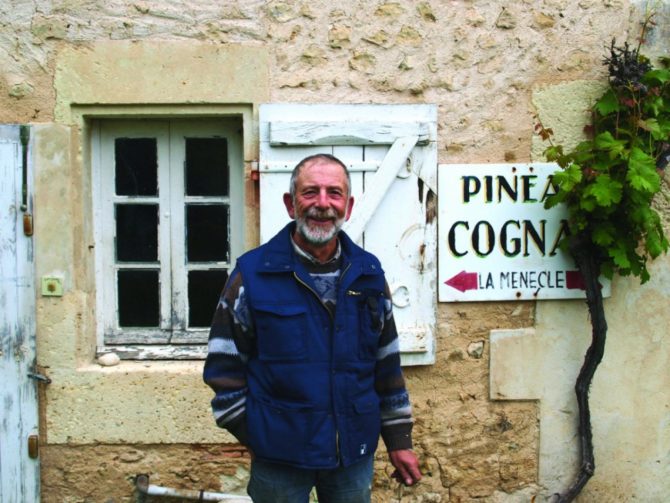Pineau des Charentes: The Celebrated Apéritif

The Charente is an unpretentious but much-loved département in South West France, an hour or so north of Bordeaux and the same distance from the Atlantic coast. Aside from the world-famous Cognac brand and a history that goes back to Roman times, it boasts few modern claims to fame. But in the small villages and hamlets of this quaint region is where you can still find la France profonde, that French way of life that is deeply immersed in the small everyday traditions of rural life, based largely on agriculture and respect for church and family.
The soft valleys of Sud-Charente are ablaze with sunflowers as I meander along a small road which is hardly more than a chemin. I follow my directions through the woods and round a bend and there is an old white sign with black lettering, advertising ‘PINEAU’, poking out of the hedgerow and inviting me to branch off down an even smaller track. The sign had seen better days and I start to wonder if maybe the owners just forgot to take it down and whether there will be anyone waiting at the other end. But then the vineyards appear, spreading out in full foliage on either side of the chemin, and I can see the grapes fattening under the canopy of vine leaves. Perhaps there will be a dégustation here after all. I hope so, because I want to find out more about one of the most pleasant apéritifs that France has to offer – Pineau des Charentes. Tricky to find outside France, it nevertheless has quite a following amongst the French and is also de rigueur with holidaymakers staying in the region who enjoy a chilled glass of Pineau Blanc or Rosé before ordering their meal at a local restaurant.
To the Manor
Meanwhile I’m still searching the vineyards for Domaine de la Ménècle. Frankly, judging by the sign, I’m expecting to see a crumbling old barn or a shed so it is a genuine surprise as a gorgeous manoir comes into view, guarded by a fearsome sounding dog (who turns out later on to be a complete softie). Jean des Courtils and his family have been making Cognac and Pineau des Charentes on this 14 hectare site for over 150 years. He shows me the vines that nestle comfortably on the southern slopes of the hill-side, and then we enter a majestic oak-framed barn that is filled with copper tanks, wooden barrels and all the inimitable aromas of fermentation.
He explains how Pineau is made from the mixing of freshly pressed grape juice with Cognac eau-de-vie. Legend has it that a winemaker in some distant century accidentally decanted grape juice into a barrel containing eau-de-vie. Later, after the mixture had fermented, the end product was considered a very pleasing accident and the practice was popularised. The lesson in wine-making over, I find myself disappointed not to be invited into the grand manoir as I had hoped, but instead Jean produces an ancient key and opens up a petite maison d’amis round the back of the family house. But things look up again as the bottles are uncorked and I realise that this is where Jean and family offer tastings and sell their limited stock to passers-by.
There are two types of Pineau – Blanc and Rosé. The Blanc is the original and can be bought non-vintage for about €9 or €10 a bottle. Colours vary, a deep gold is common, but the Pineau from Domaine de la Ménècle is paler with a tinge of apricot. The success of Pineau lies in the subtle balance of sugars, acidity and alcohol. It’s beautifully smooth but the sweetness is offset by the little bite of alcohol from the eau-de-vie – typical alcohol levels are around 17%. With that level it’s normal to have it served as an apéritif in a schooner, and it really needs to be well- chilled unless you have put some aside as a winter-warmer. If you want something with a little more soul and a bit of a kick try Le Vieux Pineau, which is aged for between 10 and 12 years. It will set you back around €20. Personally I find the non-vintage pleasingly quaffable (and it has been aged for 18 months, partly in barriques and partly en bouteille).
The Rosé (also called Rouge) is actually more of a cherry red in colour and is made with different grape varieties to the white. It is a little sweeter but still very popular as a pre-dinner tipple.
In the kitchen, Pineau also makes a great pour over some sweet Charentais melon and is an excellent base for sauces with meat dishes. Jean’s production is limited, so to buy from him and his family you will need to follow my trail to Rouffiac in the Charente. For other producers, ask your local importer or check Amazon.com groceries.
Domaine de la Ménècle, 16210, Rouffiac, France
Originally published in the October-November 2013 issue of France Today
Share to: Facebook Twitter LinkedIn Email
Leave a reply
Your email address will not be published. Required fields are marked *




REPLY